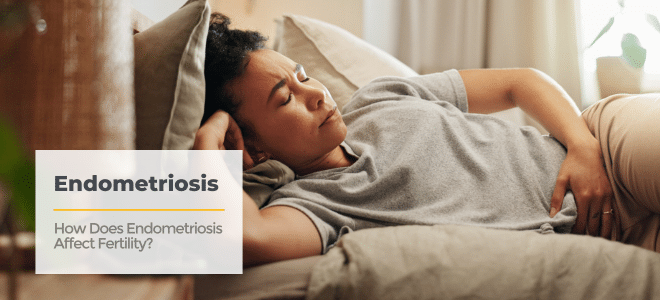
What is Endometriosis?
By A/Prof Michael Cooper OAM, Specialist at City Fertility Sydney CBD.
Endometriosis is a common health condition that affects 1 in 10 women globally – that’s about 200 million women and girls worldwide! Despite its prevalence, endometriosis continues to frustrate those living with the condition. Because endometriosis is invisible from the outside, symptoms can vary greatly from person to person. Unfortunately, the severity of endometriosis does not equal the symptoms, pain and fertility concerns a person may experience.
Endometriosis occurs when endometrial tissue from inside the uterus (womb) begin to grow outside the uterus causing pelvic pain and other issues including infertility. The areas where it is commonly found are the surface of the ovaries, the fallopian tubes, the lining the pelvis and sometimes in the bowel and bladder. Endometriosis is now considered a systemic disease rather than a disease predominantly affecting the pelvis. The full effect of the disease is not fully recognised and goes far beyond the pelvis.
How Does Endometriosis Affect Fertility?
Some women with severe endometriosis have been able to conceive naturally and have successful pregnancies, while others with milder cases can struggle to conceive. So, while there can be a link between endometriosis and infertility, it is not always the case. Other factors, particularly age, can have an effect on pregnancy prospects.
- The presence of severe endometriosis can cause a distortion of the pelvic anatomy.
- Sometimes endometriosis can impact on a woman’s chances of falling pregnant due to altered egg quality or even ovulation itself.
- Recent thinking is that the endometriosis induces an inflammatory state within the pelvis which is toxic to eggs, sperm, embryos and probably effects implantation.
- Additionally, in more severe cases endometriosis can result in distorted, swollen and blocked fallopian tubes.
If you have endometriosis and are struggling with infertility, please book an appointment with a fertility specialist.
Can Endometriosis cause infertility?
Endometriosis results in a decrease in fertility rather than absolute infertility (such as patient’s born without a uterus). In younger women, aged under 35 without reproductive health issues, the chance of a pregnancy per menstrual cycle is approximately 20% per month. Endometriosis can lower this probability, with more severe cases having an even greater impact. As endometriosis is treated the chances of conception increases.
Can you minimise the impact of endometriosis on fertility with lifestyle?
Endometriosis appears to be a chronic inflammatory disease and lifestyle measures to assist in decreasing inflammation are likely to facilitate pregnancy.
Lifestyle measures to help reduce inflammation include diet and nutrition. Eating an anti-inflammatory diet like the Mediterranean diet, maintaining a healthy weight and supporting gut health may help conception. We also recommend regular exercise and stress management. To learn more about how to boost your fertility naturally, click here.
For more information on endometriosis and common causes of female infertility, visit here. If you have concerns about endometriosis and fertility we recommend an appointment with a City Fertility specialist.
FAQs
Are endometriosis symptoms the same or can they vary?
The range of symptoms and problems we see in patients with endometriosis can vary significantly from person to person. One woman with grade 4 severity can be pain-free and lead a normal life and is only diagnosed with endometriosis during fertility investigations. Another may have mild symptoms but will need painkillers and several surgeries to help improve her health.
As we don’t yet have a blood test that can diagnose endometriosis we rely on scanning (ultrasound and MRI) and laparoscopy to assess the presence and severity of endometriosis.
Does endometriosis increase risk during pregnancy?
Endometriosis usually settles down during pregnancy due to hormones from the placenta. Many women find their pain subsides and they feel much better, with improvements in bladder and bowel function. However, this relief is not a “cure” and problems often recur after childbirth. Breastfeeding can inhibit ovulation and prevent the resumption of periods, so if period-related pain is an issue, it’s a good idea to plan to breastfeed for several months if possible.
Unfortunately, endometriosis does increase the risk of complications during pregnancy, including a higher risk of ectopic pregnancy, miscarriage, postpartum hemorrhage, hypertensive disorders, and growth retardation. These risks are not well understood, and it is unclear whether surgical removal of endometriosis reduces these complications.
References
Brosens, Pacenta 34 (2013) 100-105
Tremellen and Russell, ANZJO+G; 2011; 51; 280-283
Endometriosis is a chronic systemic disease: clinical challenges and novel innovations – PubMed
https://en.wikipedia.org/wiki/Endometriosis?
- Schliep KC, Farland LV, Pollack AZ, Buck Louis G, Stanford JB, Allen-Brady K, et al. (November 2022). “Endometriosis diagnosis, staging and typology and adverse pregnancy outcome history”. Paediatric and Perinatal Epidemiology. 36 (6): 771–781. doi:10.1111/ppe.12887. PMC 9588543. PMID 35570746.
- ^ Jump up to:a b Saraswat L (2015). “ESHRE2015: Endometriosis associated with a greater risk of complications in pregnancy”. endometriosis.org. European Society of Human Reproduction and Embryology. Archived from the original on 13 February 2024. Retrieved 14 February 2024.
- ^ Jump up to:a b Berlac JF, Hartwell D, Skovlund CW, Langhoff-Roos J, Lidegaard Ø (June 2017). “Endometriosis increases the risk of obstetrical and neonatal complications”. Acta Obstetricia et Gynecologica Scandinavica. 96 (6): 751–760. doi:10.1111/aogs.13111. PMID 28181672.















